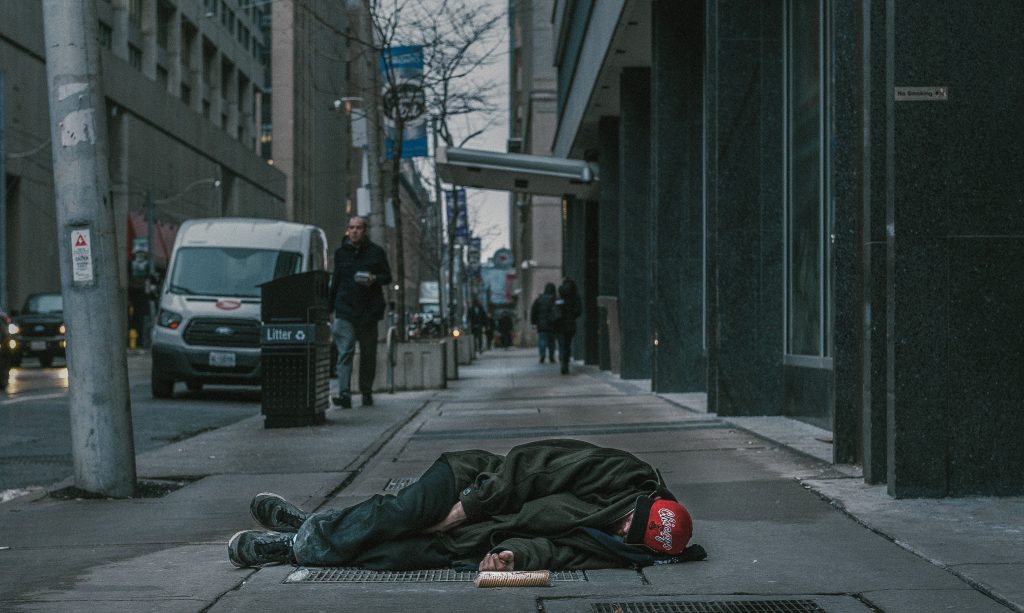10.4 Key Issues in Harm Reduction
Structural Vulnerability
- Many people with SUDs (and alcohol use disorder [AUD]) also experience structural vulnerability or disadvantage (i.e., tied to colonization, capitalism, housing instability, socio-economic disadvantage, etc.). HR initiatives can be framed to address both SUDs and the factors underlying structural vulnerability (Ivsins et al., 2019).
- PWID are vulnerable to SDoH inequities (e.g., housing instability, food insecurity, lack of social support, and poor access to health care). HR services help people experiencing SUDs to re-establish connections with health-care and social services, and make new connections with services that offer shelter to people who are unhoused or experiencing housing instability (Kermin et al., 2020).

Alcohol & Harm Reduction
- North American alcohol policy focuses predominately on moderation of use or abstinence to prevent and reduce alcohol related harms.
- Harms associated with high risk drinking among people experiencing an alcohol use disorder (AUD) and structural vulnerabilities (i.e., tied to colonization, capitalism, housing instability, socio-economic disadvantage, etc.) are inadequately addressed by conventional policies and programs (Ivsins et al., 2019).
- Managed Alcohol Programs (MAPs) aim to reduce alcohol-related harms for people experiencing structural inequalities and severe alcohol-related problems (Canadian Observatory on Homelessness, 2016; Ivsins et al., 2019).
Supervised Consumption Services (SCS)/Supervised Injection Sites (SIS)

- Provide a safe, clean space for people to consume their own substances, preventing accidental poisonings (overdose) and reducing the spread of infectious diseases (e.g., Hepatitis and HIV) (Health Canada, 2021).
- Provide opportunities to re-establish connections to and access important health and social services (Health Canada, 2021; Kerman, 2020).
- Provide potential downstream interventions to address some of the SDoH inequities experienced by PWUS and people experiencing SUDs (Kermin et al., 2020).
Indigenous Peoples & Harm Reduction
- Indigenous people are five times more likely to experience a substance-related poisoning (overdose) than non-Indigenous people. These poisoning levels are a reflection of the continuing colonial trauma experienced by members of Indigenous communities (Johnson, 2021).
- Reconciliation in Canada requires substance policy that: (a) addresses the systems creating trauma; (b) accounts for the legacy of colonization; and (c) dismantles the structural forms of racism shaping Canadian drug policies (Lavalley et al., 2018).
- The Indigenization of harm reduction and treatment tied to SUDs must integrate Indigenous values that are aligned with harm reduction principles (Lavalley et al., 2018) and include more traditional ways of healing into treatment (e.g., conversing with elders, smudging, sweat lodges, drum circles, etc.) (Johnson, 2021).
Click the links to learn more about Indigenous HR principles & practices:
Indigenous Harm Reduction Principles and Practices: Fact Sheet
First Nation in BC and the Toxic Drug Crisis
13 Moons Harm Reduction: Promising Practices in Indigenous Harm Reduction
Involvement of People with Lived & Living Experience (PWLLE)
It is important:
- To recognize the people who actually do harm reduction are people who use substances and people experiencing SUDs.
- That people with lived and living experiences be involved in policy decisions and programming that impacts their lives.
- That PWUS and HR services users be meaningfully involved in the design, implementation, review, evaluation and governance of HR programmes.(CDPC, 2020; Csete & Elliott, 2021; Harm Reduction International, n.d.; Kermin et al., 2020).
Click the link below to learn more about involving people with lived & living experience:
Drug Poisoning (Overdose) Crisis
HR initiatives play a vital role in public health responses to the drug poisoning crisis (CDPC, 2020).
Click the link to learn more about opioid and stimulant related harms:
Changing the Way We Speak
Lexiconic or vernacular changes, such as poisoned, accidental poisoning, opioid poisoning, toxic drug poisonings, drug poisoning crisis, toxic drug supply crisis, drug poisoning calls, provide more medically accurate and less stigmatizing alternatives to terms/phrases such as overdose(d), overdose crisis, overdose calls (Csete & Elliot, 2021; CDPC, 2020; The Chief Staff, 2021).
Click the link to learn more about lexiconic or vernacular changes:
Safe Supply Approach
- The disappearance of a reliable supply of heroin and major cutbacks in opioid prescriptions, has left many thousands of Canadians in a position where they must choose between purchasing unpredictable substances via illegal/unregulated sources or abstaining from use. The latter is not an option for many people experiencing a SUD (Tyndall, 2020). This problem has been exacerbated during the COVID-19 pandemic (Smith, 2021).
- Safe supply involves people who at risk of poisoning (overdose) using existing pharmaceutical-grade medications as an alternative to highly toxic street drugs. It can also establish pathways to care and treatment for people experiencing an SUD (Health Canada, 2019).
- Research demonstrates that injectable hydromorphone and diacetylmorphine (prescription heroin) are successful in helping to stabilize and support the health of some patients experiencing an opioid use disorder (OUD), including an increased retention in treatment programs (Health Canada, 2019). Canada is the first country to approve injectable hydromorphone as a treatment for severe OUD (Health Canada, 2019).
In the following video, Kieran Collins, a Vancouver man experiencing an OUD, talks about securing a spot in Vancouver’s Crosstown Clinic’s program that supplies clean injectable heroin to people with OUDs, and how it saved his life.
VIDEO: Free Heroin: The B.C. Clinic Providing an Alternative to Dangerous Street Drugs

